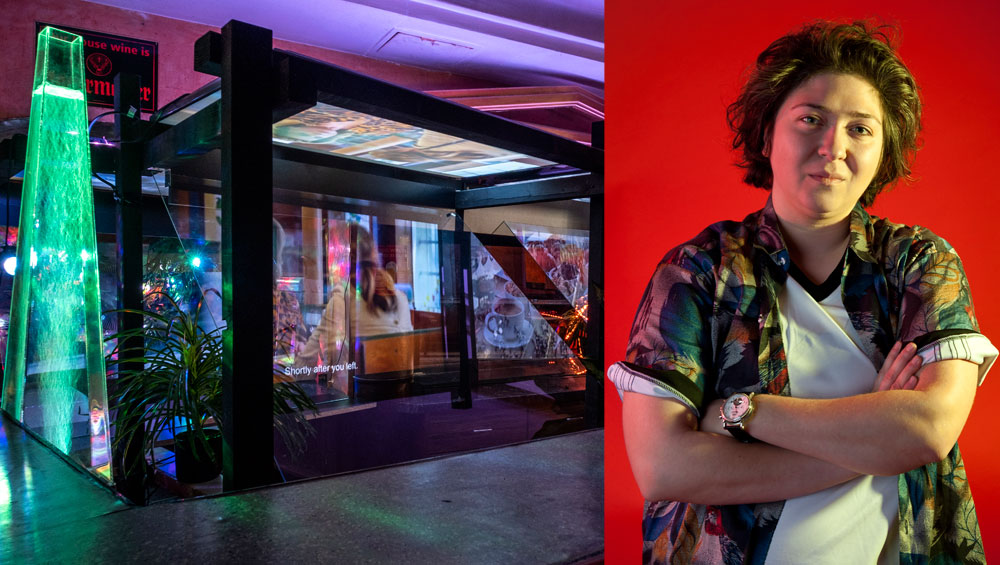
by IZABELLA SCOTT
Funda Gül Özcan (b1984) is a Turkish-German sculptor and video artist. In her recent installation It Happened As Expected (2018), which took over a derelict art deco Turkish bar in Graz, Austria, the darkened rooms were aglow with bubbling lava lamps and the flicker of screens. In these video pieces, Özcan layered up poor-quality images ripped from YouTube and the depths of the web, which collaged together on screen, but also layered up in the room itself. By laying sheets of glass over the screens, Özcan captured the reflections in the glass, creating a 3D holographic effect. Figures seemed to jump out of the screens, fragile projections that hovered, mimed and then disappeared with a pop.
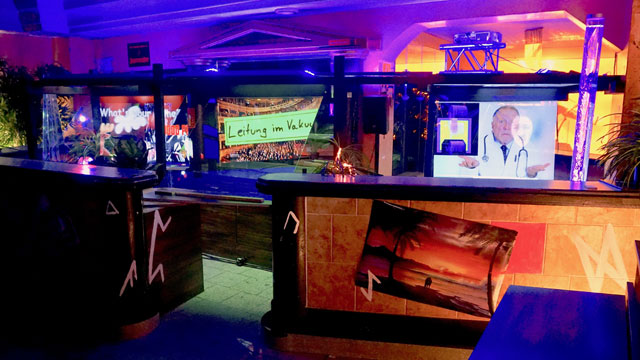
Funda Gül Özcan. It happened as expected, 2018, installation view. Multi-media video installation with sound, sculpture, painted uniforms, plastic flowers, light sources and posters. Work commissioned by Steirischer Herbst ’18. Photo: Funda Gül Özcan.
I was in Graz for a two-day conference on the rise of fascism, part of the 2018 Steirischer Herbst – an interdisciplinary arts festival that takes over the city each autumn. The neoclassical interiors of Özcan’s bar had been lit tangerine and electric blue, and the surfaces adorned with potted palms. And yet, the more time I spent reading the images that flickered in the glass, the more sinister the installation became. Between clips of talent show contests and cartoon hearts there shimmered the face of a crying man – Recep Tayyip Erdoğan, the president of Turkey. Since Erdoğan took over the presidency in 2014, he has been charged with democratic backsliding, particularly in the wake of the 2016 coup d’etat, when Turkish armed forces attempted to overthrow his government. I later email Özcan and we speak over Skype about extraterrestrials, the Kosovo war and artworks that function like pop songs.
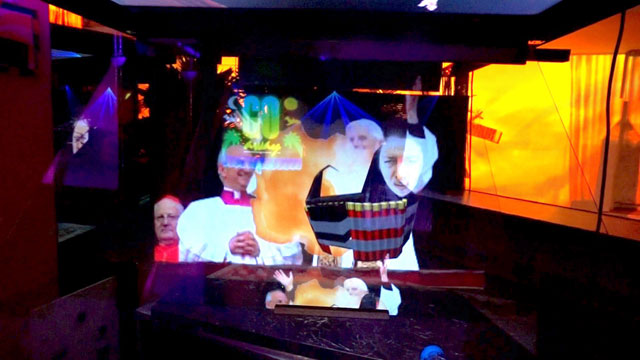
Funda Gül Özcan. It happened as expected, 2018, installation view. Multi-media video installation with sound, sculpture, painted uniforms, plastic flowers, light sources and posters. Work commissioned by Steirischer Herbst ’18. Photo: Funda Gül Özcan.
Izabella Scott: Your installation It Happened As Expected (2018) took over a derelict Turkish bar in Graz. There were a number of screens behind the bar, and among the collage of internet clips is the face of Recep Tayyip Erdoğan, the president of Turkey. He is sobbing and apologising, on loop. Why is he crying?
Funda Gül Özcan: The idea came to me as soon as I saw this Turkish bar in Graz. Before I intervened, this bar was a broken space, a ruin. When I saw it, I was reminded of an earlier time in my life. From 2006 to 2013 I was in Munich, studying at the Academy of Fine Arts and living in an area of the city where there were a lot of immigrants. There were a couple of bars where lonesome men would hang out in the evenings. One night, I was walking home from a party and I met a Turkish man outside one of these bars, and he said: “Hey, come in!” And that’s how I first went into the bar. After that, I became a regular. I would often drop by for my last drink – but, of course, it was never the last drink. I became friends with the bar owner. He never drank alcohol; he was always drinking Fanta.
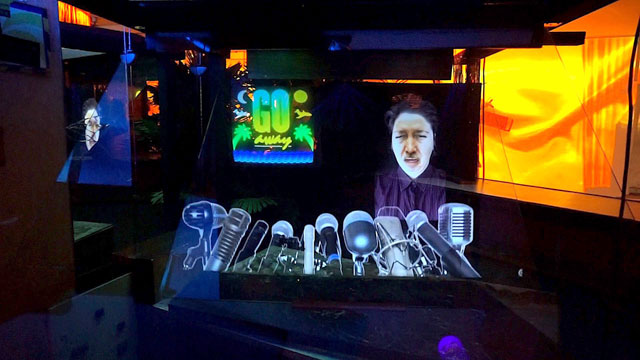
Funda Gül Özcan. It happened as expected, 2018, installation view. Multi-media video installation with sound, sculpture, painted uniforms, plastic flowers, light sources and posters. Work commissioned by Steirischer Herbst ’18. Photo: Funda Gül Özcan.
I got to know the Turkish men who drank there and I discovered they were really nice guys. As a single woman, it’s not exactly somewhere I thought of entering. But it wasn’t a threatening space. My parents moved from Turkey in the 70s and I was born in Bavaria, but I feel very mixed culturally. I speak Turkish, so I could communicate with these guys in German and Turkish. I never felt they were attracted to me. I think they realised I was a queer woman, and they didn’t try to flirt with me, but treated me as a buddy. The first night I went in, one man started playing the guitar and singing old Turkish songs. The songs made me cry! If you’re a little drunk, you can get so emotional. After this, I began visiting the bar quite often. As I sat at the bar, these men would slouch next to me, and tell me their problems. I gave them my ear, and they told me their stories, breaking down as they did so, spilling tears. So, when I saw this Turkish bar in Graz, it just looked so similar to that bar in Munich. And I thought: who is going to cry in this bar?
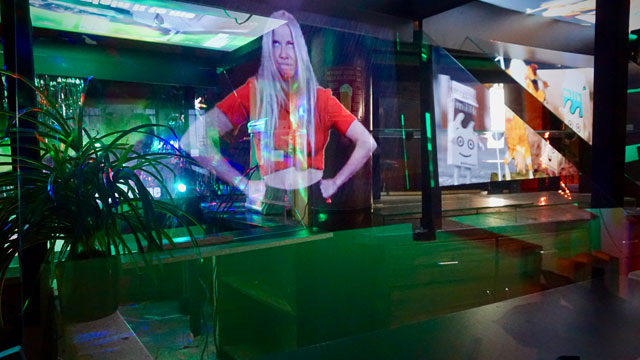
Funda Gül Özcan. It happened as expected, 2018, installation view. Multi-media video installation with sound, sculpture, painted uniforms, plastic flowers, light sources and posters. Work commissioned by Steirischer Herbst ’18. Photo: Funda Gül Özcan.
IS: And you immediately thought of Erdoğan?
FGO: I was thinking of these “strong men” whom I met in Munich. As they broke down in front of me, I understood the way in which they felt enticed to perform a certain role, because of the macho mechanisms in society, especially in Turkish society. In these bars, as they cried, these “strong men” became vulnerable and human. Erdoğan is another of these “strong men”. There’s also something important to say with regards to the way he is represented in my bar. During the 2016 military coup d’etat, Erdoğan made a speech on Turkish television, using FaceTime. In this speech, he urged citizens to take to the streets, to “stop the coup”, and to take back the country from the military force. I found this use of FaceTime really interesting, the way he spoke to the public as if by cell phone, to create a sense of intimacy. I made an image of his face, using my face, as I cried in this Turkish bar. At base, I wanted to see Erdoğan crying. The more time I spent in this bar, the more I needed to see it. It was my wish.
IS: How did you merge your face with his to make this image?
FGO: It’s actually a function on Snapchat, where you can morph faces together. The quality of the image is pretty crappy, but the function itself clearly has huge implications. By morphing the faces of famous politicians, say, on to videos you make at home, you can create fake documents. I don’t want to create fake news per se, but I do want to hijack the software to create this impossible image of Erdoğan. I don’t even want to say Erdoğan, I want to say ET, an extraterrestrial. He’s an alien, because he’s not a human. And making him cry is in some way humanising him. He weeps, giving a tearful apology, saying: “I’m sorry, I’m sorry …” over and over again.
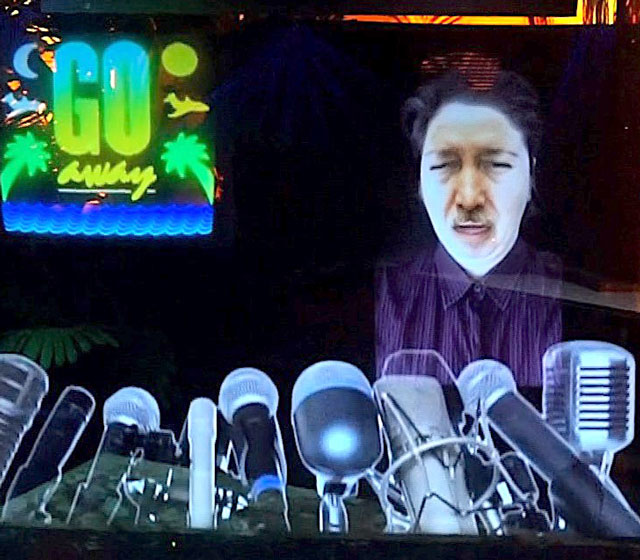
Funda Gül Özcan. It happened as expected, 2018, installation view. Multi-media video installation with sound, sculpture, painted uniforms, plastic flowers, light sources and posters. Work commissioned by Steirischer Herbst ’18. Photo: Mathias Voelzke.
IS: It is interesting that you say “humanising”; in some ways, creating an image of the president crying is more akin to a kind of iconoclasm. You are forcing an apology, and actively working against the image he and his political party have fostered.
FGO: I’m invested in the mode of apology. I think it’s an incredibly important currency: we need more acts of apology. On the one hand, I’m asking ET to cry, to become human. I want people watching this to look at their own lives, to think about when they last apologised. So, there’s a sincerity there. But on the other hand, when you see this image of ET, this hologram of our morphed faces, it’s clear that it’s an apparition. It’s obvious it’s fake. You might even call ET’s tears “crocodile tears”.
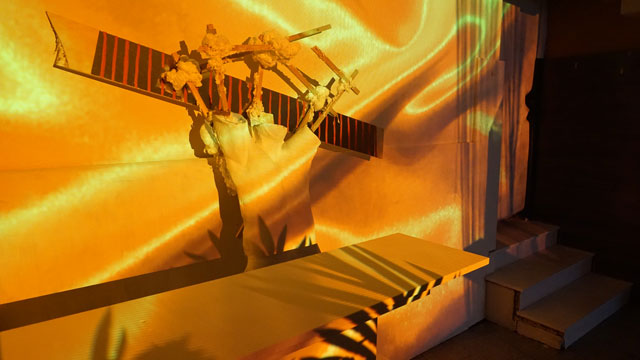
Funda Gül Özcan. It happened as expected, 2018, installation view. Multi-media video installation with sound, sculpture, painted uniforms, plastic flowers, light sources and posters. Work commissioned by Steirischer Herbst ’18. Photo: Funda Gül Özcan.
IS: Yes, there is something very thin about the image, perhaps even queer or camp, in this apparitional figure: he is almost a clown, with a painted white face, streaked with tears. Were you think of camping ET, as you want to call him, turning him into a kind of mime artist, or Pierrot?
FGO: The face is cartoon-like – it’s a caricature. And it’s part of a much greater collage of images, which play out over the screens behind the bar. The face of ET is the most explicit image, in that it uses a particular identity. The other images are more amorphous, and more difficult to pin down. In making this visual collage, I began by writing a poem – a narrative poem, a dark satire, full of all sorts of crazy images. Once I had written the poem, I wanted to materialise my thoughts as images, to make it visual. So I took the poem and I Googled each of the words or phrases to see what I found. I wrote into the darkness, and then I found that so many people had already made these images already.
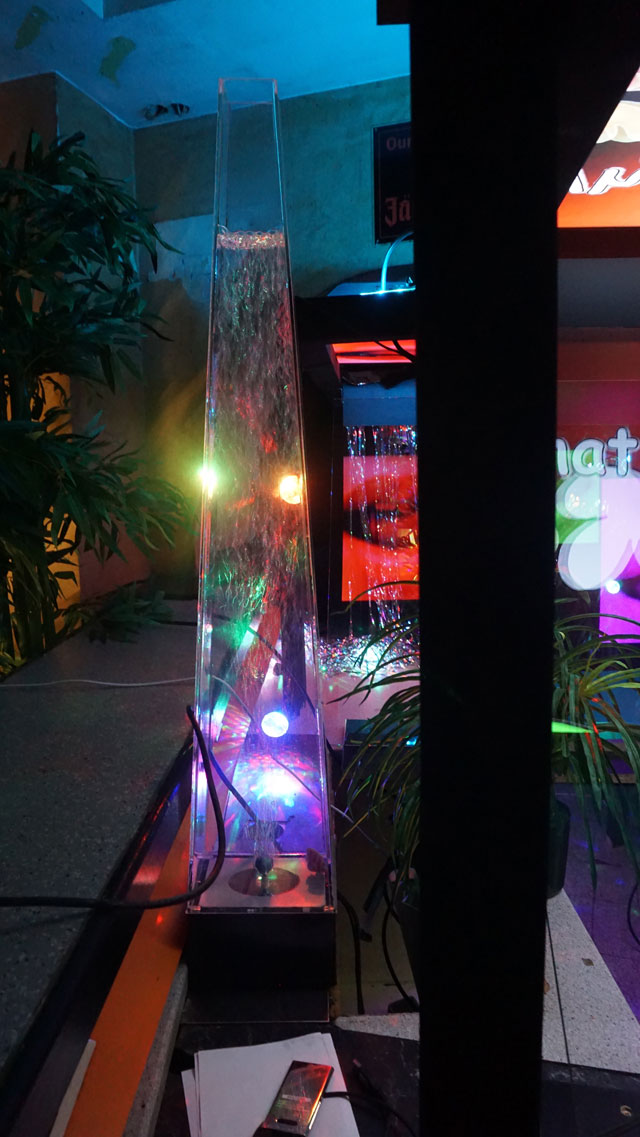
Funda Gül Özcan. It happened as expected, 2018, installation view. Multi-media video installation with sound, sculpture, painted uniforms, plastic flowers, light sources and posters. Work commissioned by Steirischer Herbst ’18. Photo: Funda Gül Özcan.
All of the images I’ve stitched together are cheap, low-res downloads and gifs – poor images ripped off the internet. There are clips from Turkish TV, home videos and other strange images I came across on the web. To give you an example, in one part of the poem, I wrote about different species of chaos and, in my searches, the internet threw up images of laughing demons, cyborg armies and even Voodoo priests. It’s fascinating.
I then took all of these images, and layered them up – and not just using software to layer on a screen, but layering the images up in an analogue manner. I devised a way of placing the screens face down, and then placing a sheet of glass on top, at an incline. The glass reflects the images in the screen at a 90-degree angle – it’s the same science as when you have a candle in front of a dark window and you see the illusion of the candle reflected at a distance. In my work, the sheets of glass reflect and illuminate the videos on the screens, creating a 3D, holographic effect. The result is really a glut of layered reflections, which are seen on many planes at once. I’m interested in the overdose.
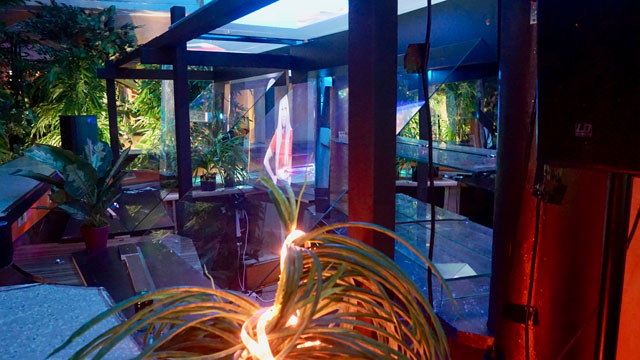
Funda Gül Özcan. It happened as expected, 2018, installation view. Multi-media video installation with sound, sculpture, painted uniforms, plastic flowers, light sources and posters. Work commissioned by Steirischer Herbst ’18. Photo: Funda Gül Özcan.
IS: What is the narrative in your poem? Is it about a weeping dictator?
FGO: I was thinking again of those Turkish men in Munich, whom I met as a student. These men told me about their arranged marriages, the unhappiness of their private lives – and there are lots of images of marriage folded into the sequence, images of social expectation. But the poem is also about me – it’s a kind of epic about my own life. The videos are on a loop so it’s difficult to see this, but the first images reference my birth. There is a baby that appears in the Bavarian landscape.
IS: So it’s a mixture of the fictive and the personal – a combination of the stories you heard from the Turkish men and stories that are inside you. Were there any images you didn’t expect to find online?
FGO: There is a moment in the poem where somebody eats a human placenta. I found an image online of a placenta being fried up in a pan. This was unexpected. I had been thinking that it would be difficult to make this video. How to find a placenta that I can eat? It made me very thankful to the internet, and to all these people who upload their videos.
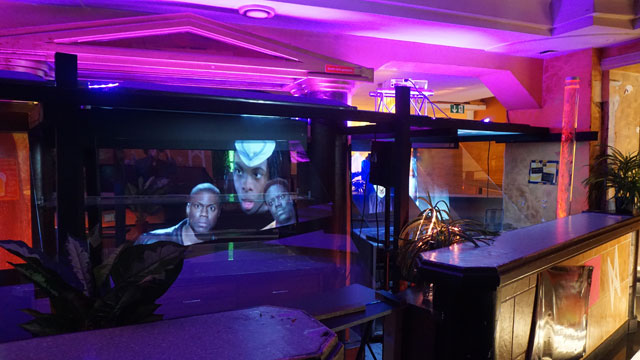
Funda Gül Özcan. It happened as expected, 2018, installation view. Multi-media video installation with sound, sculpture, painted uniforms, plastic flowers, light sources and posters. Work commissioned by Steirischer Herbst ’18. Photo: Funda Gül Özcan.
IS: Do you think of the internet as a kind of collective database, that you can dive into? A way of accessing collective consciousness?
FGO: There’s always some video attesting to the fact this image happened elsewhere, and if I cannot find the video, I produce it. But it’s rare. Really, the only thing I couldn’t find online was ET crying. I should say that this collage mode is quite a new aesthetic for me – ripping images off the internet and recombining them in a kind of post-internet aesthetic. My background is in sculpture, and when I found these images, my urge was to use them as solid material – to turn them into sculpture. This is why I work with sheets of glass and reflections.
IS: At the very back of the bar is a second area, where you have projected golden light, like a sunset, on to a kind of altar with an effigy that has a human body and an animal head. Is this a memorial? To whom?
FGO: The golden projection you talk of comes from a very painful source: it is footage of the 2015 Suruç bombing, in which more than 30 people were killed in the town, which lies in southeast Turkey. For me, this was one of the saddest moments in recent Turkish history. Most of the victims were members of the Federation of Socialist Youth Associations. They were young socialists and doctors, who were planning to go to help rebuild Kobani, a city in Syria that had been under siege by Islamic State. The suicide attack was devastating.
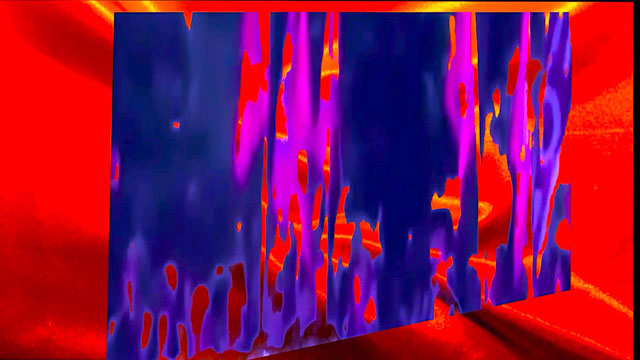
Funda Gül Özcan. It happened as expected, 2018. Video still. Courtesy Funda Gül Özcan.
I had to think carefully about how to use the footage of these attacks, which you can find online. I manipulated and stretched the images, abstracting the flames. This part of the bar has a different mood to the other side where ET sobs. It’s more sombre. The explosion is projected on to a sheet of fabric that moves slightly in a constant rippling. There is a drumbeat in the background, an old Turkish military march, and it’s this drumbeat that makes the silk fabric ripple – it comes out of a subwoofer, and the beats are made visible in the silk. It’s the sound of a certain kind of patriotism.
IS: Do you blame ET for the 2015 bombing? Is there a direct link between ET’s apology and this memorial?
FGO: Rather than an explicit link, I see it more as a butterfly effect. When ET became president in 2014, Turkey began to change. It’s the climate created by ET that has led to the violence we see in Turkey today; he is the one who is guilty. But there is another reason I included this footage in the bar. I grew up in the town of Garmisch-Partenkirchen, a touristy ski resort in Bavaria, in the very south of Germany, right on the border with Austria.
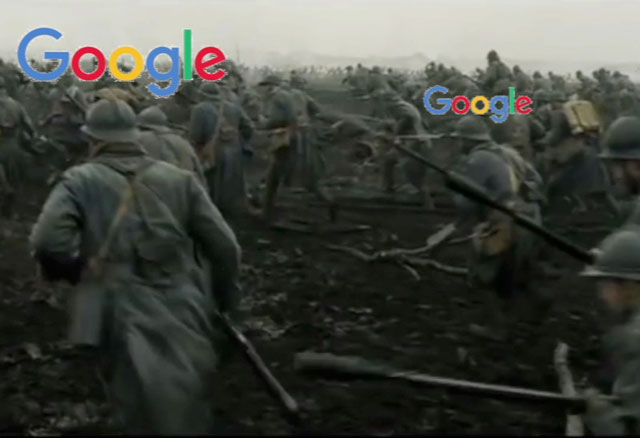
Funda Gül Özcan. It happened as expected, 2018. Video still. Courtesy Funda Gül Özcan.
When I was a teenager, I had a lot of friends from Albania. I loved these guys. At this point in my life, I didn’t have many German friends, and I was hanging out at youth clubs, were there were a lot of migrant kids or refugees, and especially young guys from Albania. This was the end of the 90s, and we’d all go out to bars together, or to the disco. When these friends of mine were drunk, while we were on the dance floor, they would begin to tell me their war stories. These Albanian boys had been in the Kosovo war, and when we were in the discotheque, listening to Britney Spears, they would start to breakdown. They would begin to tell me that they had shot a child in the head, or some other terrible act. Imagine it: you are on the dance floor, sipping your alcopop, dancing to a pop song, and the person talking to you – it’s your best friend – he’s telling you that he killed a child. I’ve never been able to forget these conversations. A bar isn’t the most obvious place to talk about war but, for me, this is where these conversations took place. Manipulating the footage from Suruc is a way to pay tribute to the people who died, and also to speak of my Albanian friends, these young guys who experienced such atrocities at such a young age.
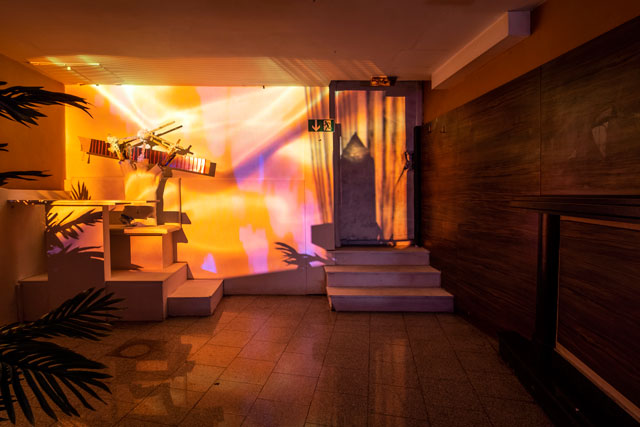
Funda Gül Özcan. It happened as expected, 2018, installation view. Multi-media video installation with sound, sculpture, painted uniforms, plastic flowers, light sources and posters. Work commissioned by Steirischer Herbst ’18. Photo: Mathias Voelzke.
IS: You’ve had such a particular experience, where the bar is a place that men can feel safe enough to confess or articulate trauma. These bars you talk of are clearly heterosexual spaces, but there is something of the gay bar, even as metaphor, in the way these guys are “coming out of the closet”, so to speak, about their trauma. Are you constructing a “bar theory” of sorts, where the bar might be a cathartic space for certain kinds of traumatised men?
FGO: I think I had a unique position when I entered these spaces – both in the 90s as a teenager and when I was a student in Munich – by the very fact of being a woman, and being a queer woman. On the one hand, there are some quite traditional gender roles being played out. These various types of “strong men” I’m talking about – whether Albanian boys or Turkish dads – would never allow themselves to cry in front of their male buddies. They saw me as a friend, but also a woman. I was like a sponge to soak up their tears.
With my Albanian friends, I remember the moment when it all became very real. An Interpol agent arrived. It happened one evening – suddenly there was an Interpol agent. I was asking: Who is this guy? Why is he here? It turned out that they all knew each other from the Kosovo war. The agent had come to visit them. I remember he had a bundle of euros, yens and dollars and he spoke eight languages – Turkish, too. It was only when I met this agent that the stories these guys had told me became fully real. Also, as soon as the agent appeared, my friends stopped crying. They turned into cool, “strong men” again. They started asking me to help them chat up girls. They started to fight too, getting violent with each other and returning to a kind of basic machismo. They changed so much that one day I thought: I can’t stand these guys any more! But their stories stayed with me. I think I’m a little traumatised by them, too.
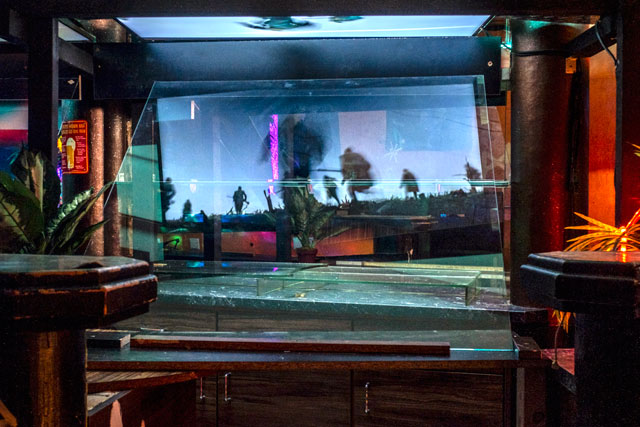
Funda Gül Özcan. It happened as expected, 2018, installation view. Multi-media video installation with sound, sculpture, painted uniforms, plastic flowers, light sources and posters. Work commissioned by Steirischer Herbst ’18. Photo: Mathias Voelzke.
IS: Why do you think people tell you their stories? I can’t help but think of Rachel Cusk and her trilogy of novels, which begins with Outline (2014). The book is made up of conversations that her narrator, Faye, recounts. Often, Faye seems to say almost nothing as different people she meets pour out their stories. It’s a book of monologues and Faye is a kind of vanishing perspective. But in the process of reading it, I kept thinking: who is Faye? Why do people tell her their secrets?
FGO: I have always wondered why people tell me their stories. I have certain theories. It’s most often men who speak to me, and perhaps it’s because I occupy an atypical space: they don’t find me attractive, and yet I’m a woman, so I become a kind of neutral person – somewhere between a therapist and a mother. I’m also emotionally involved. I give people time and attention. I’m willing to empathise – it’s part of my character. I don’t get depressed by these stories, but I do have a very good memory, so I remember every detail; it’s almost cinematic. These stories don’t go away, they stay with me, so part of my desire to make art is to do something with these stories. I have to get them out of my head, to turn them into material. Of course, we see many so many images of war on the news, and there are many kinds of images to provoke empathy – but still, hearing these stories first-hand, that has a particular power.
IS: Would your Albanian friends recognise themselves in this bar? Do you think they would find the residue of their stories and their teenage years, here?
FGO: I wanted to capture a mood. In fact, I wanted to make an artwork that functioned like a pop song. By turning my poem into a glut of images, I was creating a visual pop song. But it’s an aesthetic of pop that is run through with something else – images of suicide bombers, crying dictators, exploding balls of fire. This is because every time I was in the bar or disco, as the pop songs played in the background, I heard war stories or miseries being recounted. So, there are these bad vibes, or bad feelings, beneath the pop beats. This is what I want the experience of entering the bar to be like: at first, you feel happy, coddled, even entertained. But as time goes on, you feel something else, a sort of heaviness. It’s really not the space you first thought.